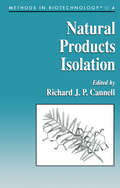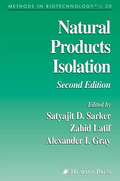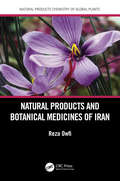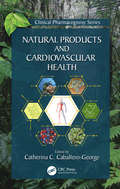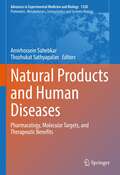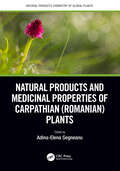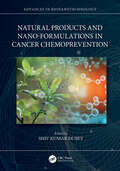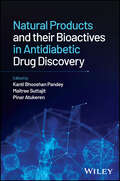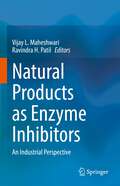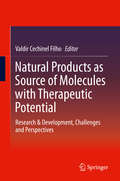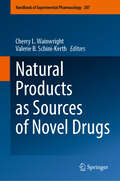- Table View
- List View
Natural Products Isolation
by Richard J. CannellResearchers from both industry and academia present in detail techniques for the extraction and isolation of natural products of all classes. These experienced experimentalists describe a wide array of methodologies, including basic chromatography, ion-exchange methods, HPLC, countercurrent and planar chromatography, SFE, and crystallization. They also address the specific problems involved in working with plants, marine organisms, water-soluble compounds, scale-up, dereplication and partial identification, and follow-up of a natural product lead. For the less-experienced they offer hands-on advice-using real examples-about how to approach an extraction in general, when and why to apply a particular technique, how to carry out the methods described, and how to modify conditions according to the compound being isolated.
Natural Products Isolation
by Satya D. SarkerThis new edition of Natural Products Isolation has been not only significantly updated to reflect recent advances in the field, but has also been expanded with three new chapters on hyphenated techniques, purification by solvent extraction using partition coefficient, and isolation of microbial natural products. The book includes powerful cutting-edge techniques and simple basic techniques that can save time and effort, as well as achieve results equivalent to using some of the more modern and expensive methodologies. The protocols follow the successful Methods in Molecular BiologyTM series format, each offering step-by-step laboratory instructions, an introduction outlining the principles behind the technique, lists of the necessary equipment and reagents, and tips on troubleshooting and avoiding known pitfalls.
Natural Products and Botanical Medicines of Iran (Natural Products Chemistry of Global Plants)
by Reza Eddin OwfiWith a high diversity of vegetation in Iran, over 8000 plant species are in existence. More than 2300 species of these plants have medicinal, edible and industrial properties, and more than 1700 species of them are endemic. Natural Products and Botanical Medicines of Iran provides an overview on important endemic plants and their usages. All results have been tabulated and key detailed information of each species is presented with background data. Features: Provides an understanding of indigenous plant-derived natural medicines of the most important medicinal plants in the region Includes discussions and critical views on the potentials and challenges for further development of the selected plants in a modern setting Details the important plants and sets out the chapters based on either taxonomy or medical use
Natural Products and Cardiovascular Health (Clinical Pharmacognosy Series)
by Catherina Caballero GeorgeThis unique volume provides the latest information on secondary metabolites obtained from selected organisms (plants or microorganisms) that have beneficial effects in the treatment of cardiovascular diseases and an ability to offer protection against their progress. A detailed description of their source, chemistry and mechanism of action is provided, together with results of clinical studies. Here, a clear connection is made between chemical structures, in vitro studies and their clinical significance.The topic is extensive and the audience gains an understanding of the medicinal applications of these groups of secondary metabolites that have the potential to improve cardiovascular health. Features: The latest information on secondary metabolites with beneficial effects in the treatment of cardiovascular diseases. Written by an outstanding team of authors, their work provides new insights into the beneficial effects of different components present in well known plant products, evidencing their impressive cardiovascular effects. This volume discusses novel targets to screen for new drugs and the need for data obtained from clinical studies using natural products in order to better analyze the significance of in vitro experimental data. Here the reader will find a unique and timely volume with an international flavor. This book describes the source, chemistry and mechanism of action of natural products with the potential to improve cardiovascular health.
Natural Products and Human Diseases: Pharmacology, Molecular Targets, and Therapeutic Benefits (Advances in Experimental Medicine and Biology #1328)
by Amirhossein Sahebkar Thozhukat SathyapalanNatural products have a long history of use as folk medicines in several systems of traditional medicine. Extensive evidence from modern pharmacological studies has confirmed traditional applications, and unveiled the vast potential of naturally occurring compounds, particularly plant-derived phytochemicals, in the management of chronic human diseases. The past decade has witnessed a surge of findings from randomized controlled trials testifying the safety and efficacy of natural products as adjuncts or alternatives to standard-of-care medications for several illnesses. Biomolecular studies have unveiled hundreds of cellular and molecular targets for phytochemicals including key transcription factors, receptors, enzymes, hormones, neurotransmitters, cytokines, lipids, and non-coding RNAs.Extensive research on the preventative and therapeutic effects of natural products necessitates regular updating of the literature as to the developing potential roles of these compounds in different human diseases. This new book provides an overview of the current pharmacological and clinical features of natural products, and the role of phytopharmaceutical compounds in health and diseases. Chapters cover a wide scope, from cancers, to chronic and age-related disorders, and are written by leading international subject experts. Collectively, chapters will provide useful insights on the regulatory effects of phytochemicals and nutraceuticals on pathogenic molecular signatures associated with pathologies, disease biomarkers, and aging-related pathways.
Natural Products and Medicinal Properties of Carpathian (Natural Products Chemistry of Global Plants)
by Adina-Elena SegneanuRomanian ethnomedicinal knowledge extends as far back as the 16th century to the Geto-Dacian priests who used medicinal plants and practiced integrated holistic medicine. The ethnomedicine continued in monasteries by monks who used cultivated medicinal plants and wild harvested plants. There are now over 800 species of medicinal plants in Romania. An earlier work last century entitled “Pharmaceutical Botany: the Culture and Harvest of Pharmaceutical Plants” by Grinţescu refers to approximately 500 Romanian healing plants, although most of them are not recognized in modern medicine. There is clear evidence of ethnomedicine in this important region, particularly those that are endangered.Features: • Provides an understanding of indigenous plant-derived natural medicines of Romania • Discusses selected plant families that are representative members of the most important medicinal plants in the region. • Includes discussions and critical views on the potential and challenges for further development of the selected plants in a modern setting • Details the important plants and organizes the chapters based on either taxonomy ormedical use • Covers traditional and folk medicine of Romania.
Natural Products and Nano-Formulations in Cancer Chemoprevention (Advances in Bionanotechnology)
by Shiv Kumar DubeyThis book covers various aspects of cancer chemoprevention, including an overview of chemoprevention in the process of tumorigenesis; the roles of various phytochemicals, functional foods, and dietary interventions in disease prevention; and techniques such as cancer stem cell targeting, nano-formulations, and so forth. The nutrigenomic and epigenetic effects of natural products at the molecular and genetic levels are also covered alongside their potential for additive and synergistic effect, as well as overcoming drug resistance. The key selling features of the book are as follows: Discusses holistic and comprehensive areas of chemoprevention Includes diverse techniques, such as cancer stem cell targeting, nano-formulations, and nanotechnology-based drug delivery systems Introduces various mechanisms involved in prevention of the diseases, including targeting cancer stem cells Reviews various aspects which can reduce the toxicity and cost of treatment of diseases by alternative medicine Explores various sources, mechanisms, and ways to develop cancer chemopreventive agents with minimal toxicity compared to traditional cancer therapy drugs This book is focused on researchers and graduate students in drug delivery and formulation, nanobiotechnology, cancer chemoprevention, prevention, and therapeutics.
Natural Products and their Bioactives in Antidiabetic Drug Discovery
by Kanti Bhooshan Pandey Maitree Suttajit Pinar AtukerenNatural Products and their Bioactives in Antidiabetic Drug Discovery Enables researchers to effectively understand and use bioactive compounds to target, prevent, and manage diabetes Natural Products and Their Bioactives in Antidiabetic Drug Discovery provides readers with an overview of recent research in new drug discovery against diabetic complications based on bioactives from NPs, bridging the gap between the public research institutes and private companies working to find drugs to treat diabetes. To aid in reader comprehension, the text includes case studies and illustrated examples in relevant chapters. Part one presents chapters on fundamental concepts of diabetes mellitus (DM) and recent drug discovery progress along with the various druggable targets and challenges. Part two covers bioactive compounds targeting Type-1 Diabetes. Part three focuses on Type-2 Diabetes. In Part four, the contributors address gestational DM prevention and management with natural compounds. Written by a global team of experts in the field, Natural Products and their Bioactives in Antidiabetic Drug Discovery covers sample topics such as: Obesity risk factor in patients with T1DM and possible role of nutritional therapy in its management Use of natural non-insulin drugs as a novel approach to enhance therapeutic outcomes against T1DM Effectiveness of functional foods in intervening the diabetic complications and realistic results in clinical trials Implementation of nanotechnology in improving the bioavailability and reducing the threshold dose of bioactive compounds Various antidiabetic mechanisms of action of different polyphenols and immunomodulatory role of NPs bioactives relevance in T1DM therapy Effects of natural products on genetics of gestational diabetes With comprehensive coverage of recent research in new drug discovery against diabetic complications based on bioactives from NPs, Natural Products and Their Bioactives in Antidiabetic Drug Discovery is an essential resource for researchers and professionals involved in drug discovery and development, health care, medicinal chemistry, phytochemistry, plant science, and toxicology.
Natural Products as Enzyme Inhibitors: An Industrial Perspective
by Ravindra H. Patil Vijay L. MaheshwariThis book provides an overview of the latest developments and future challenges in enzyme inhibitor research. It discusses the general enzyme inhibitory principles and mechanisms in enzyme activity regulation and application of enzyme inhibitors in different areas and sectors. The major areas of applications of enzyme inhibitors covered in this book are human health management, agriculture, food processing and research, which leads to drug discovery or enzyme activity mechanisms. The book also identifies the gaps in the existing knowledge and opens up new research ideas in this important area. Currently, most enzyme inhibitors are reported to inhibit various classes of enzymes. These enzyme inhibitors are the focus of the scientific community because they may answer an increasing array of questions in the research area of biological sciences, including biochemistry, medicine, physiology, pharmacy, agriculture, ecology etc. It also serves as a useful tool in the study of enzyme structures and reaction mechanisms and in the development of technologies in agriculture, food processing, and health management. Chapters in this book cover topics such as plant-derived inhibitors of serine proteases, pancreatic lipase (PL) inhibitors from indigenous medicinal plants, amylase inhibitors and their applications in agriculture and food processing industries and advances in silico techniques used in the study of enzyme inhibitors. The book will serve as a valuable resource for students and researchers in Life Sciences, agriculture, medicine, food processing, and allied industries.
Natural Products as Source of Molecules with Therapeutic Potential: Research And Development, Challenges And Perspectives
by Valdir Cechinel FilhoThis book addresses the highly relevant and complex subject of research on drugs from natural products, discussing the current hot topics in the field. It also provides a detailed overview of the strategies used to research and develop these drugs. Respected experts explore issues involved in the production chain and when looking for new medicinal agents, including aspects such as therapeutic potential, functional foods, ethnopharmacology, metabolomics, virtual screening and regulatory scenarios. Further, the book describes strategic methods of isolation and characterization of active principles, biological assays, biotechnology of plants, synthesis, clinical trials and the use of tools to identity active principles.
Natural Products as Sources of Novel Drugs (Handbook of Experimental Pharmacology #287)
by Cherry L. Wainwright Valerie B. Schini-KerthThis book reflects the state of the art in the field of natural product drug discovery. The work explores what advances have been made in discovering novel compounds from terrestrial, marine and microbial sources for use in the treatment and management of both non-communicable (e.g. cardiovascular, neurodegenerative) and communicable (e.g. malaria) diseases. Each chapter is authored by international experts who present detailed analysis of the pipeline of natural product-derived drugs in their field. This book makes a valuable contribution to the field and appeals to researchers in all branches of natural product research.
Natural Products for Antibacterial Drug Development: Recent Advancement of Computational Approach
by Tripti Sharma Chita Ranjan Sahoo Debdutta Bhattacharya Sanghamitra PatiThe book focuses on the rampant use of higher-dose antibiotics in human routine consumption and how it leads to bacterial resistance to multiple drugs. Book chapters focus on the result of their overuses and concomitant misuses, and how antibiotics have become synonymous with the unending hellish experience that is antimicrobial resistance by pathogenic microbes. It also talks about the challenges associated with the treatment of bacterial infections and challenges to mankind due to the development of high rates of antibiotic resistance. This book also provides information about developments of antibacterial drugs from natural sources. In addition, it also covers different computational approaches used for antibacterial drug development from natural sources in recent times. Finally, the book also elucidates a detailed outline of bacterial resistance status, current treatment methods, natural products as an opportunity for the development of potent druggable candidates, and methods of antibacterial drug development. This book serves as a great resource for students, researchers, and academicians in the field of pharmacology.
Natural Products from Actinomycetes: Diversity, Ecology and Drug Discovery
by Jamuna A. Bai Ravishankar V. RaiThis book provides in-depth information about the ecology, diversity and applications of Actinomycetes. The book is divided into two major parts. The first part discusses the diversity, chemical biology and ecology of Actinomycetes. It also covers the discovery of natural products from soil, endophytic and marine-derived Actinomycetes. It includes natural product discovery, chemical biology, new methods for discovering secondary metabolites, structure elucidation and biosynthetic research of natural products. The chapters in this part focus on the effects of biological and chemical elicitation at molecular level on secondary metabolism in Actinomycetes. The second part of the book discusses genomic and synthetic biology approaches in Actinomycetes drug discovery. This part includes chapters focused on the application of metabolic engineering to optimize natural product synthesis and the use of omics data in engineering of regulatory genes. It covers the advanced tools of synthetic biology and metabolic engineering including cluster assembly, CRISPR/Cas9 technologies, and chassis strain development for natural product overproduction in Actinomycetes. It describes the use of bioinformatics tools for reprogramming of biosynthetic pathways through polyketide synthase and non-ribosomal peptide synthetase engineering. These advanced genomic and molecular tools are expected to accelerate the discovery and development of new natural products from Actinomycetes with medicinal and other industrial applications. The book is useful to researchers and students in the field of microbiology, pharmaceutical sciences and drug discovery.
Natural Products from Plants
by Peter B. Kaufman Leland J. Cseke Ara Kirakosyan Sara Warber James A. Duke Harry L. Brielmann2008 NOMINEEThe Council on Botanical and Horticultural Libraries Annual Award for a Significant Work in Botanical or Horticultural Literature From medicinal, industrial, and culinary uses to cutting-edge laboratory techniques in modern research and plant conservation strategies, Natural Products from Plants
Natural Products in Beverages: Botany, Phytochemistry, Pharmacology and Processing (Reference Series in Phytochemistry)
by Jean-Michel Mérillon Céline Rivière Gabriel LefèvreThis reference book provides an overview of the active ingredients of selected plants present in beverages. The book aims to highlight according to the chapters the botanical, ethnobotanical, ecological or agronomic aspects of these botanical species used in some well-known or rarer beverages by linking them to their phytochemistry. This book also covers the manufacturing techniques, as well as the quality control of these products of natural origin in beverages. The content is divided into five main sections containing chapters written by valuable experts in their field : (1) beverages plants with caffeine and other methylxanthines, (2) beverage plants without caffeine, (3) fruits juices, (4) alcoholic beverage plants: non-distilled beverages and (5) alcoholic beverage plants: distilled beverages. The book is a useful resource for graduate students, academics and researchers in the field of botany, agriculture, food chemistry, nutrition as well as for industrial scientists and those involved in the commercialization of phytochemicals, plants and their extracts.
Natural Products in Cancer Prevention and Therapy
by John M. Pezzuto Nanjoo SuhChemoprevention of Esophageal Squamous Cell Carcinoma with Berries, by Gary D. Stoner and Li-Shu Wang Cancer Prevention by Different Forms of Tocopherols, by Chung S. Yang and Nanjoo Suh Cancer Chemopreventive and Therapeutic Potential of Guggulsterone, by Inas Almazari and Young-Joon Surh Inhibition of UVB-Induced Nonmelanoma Skin Cancer: A Path from Tea to Caffeine to Exercise to Decreased Tissue Fat, by Allan H. Conney, You-Rong Lou, Paul Nghiem, Jamie J. Bernard, George C. Wagner and Yao-Ping Lu Cancer Chemoprevention and Nutri-Epigenetics: State of the Art and Future Challenges, by Clarissa Gerhauser A Perspective on Dietary Phytochemicals and Cancer Chemoprevention: Oxidative Stress, Nrf2, and Epigenomics, by Zheng-Yuan Su, Limin Shu, Tin Oo Khor, Jong Hun Lee, Francisco Fuentes and Ah-Ng Tony Kong Keap1-Nrf2 Signaling: A Target for Cancer Prevention by Sulforaphane, by Thomas W. Kensler, Patricia A. Egner, Abena S. Agyeman, Kala Visvanathan, John D. Groopman, Jian-Guo Chen, Tao-Yang Chen, Jed W. Fahey and Paul Talalay Chemoprotection Against Cancer by Isothiocyanates: A Focus on the Animal Models and the Protective Mechanisms, by Albena T. Dinkova-Kostova Human Cancer Chemoprevention: Hurdles and Challenges, by Vaqar Mustafa Adhami and Hasan Mukhtar Personalizing Lung Cancer Prevention Through a Reverse Migration Strategy, by Kathryn A. Gold, Edward S. Kim, Ignacio I. Wistuba and Waun K. Hong Natural-Agent Mechanisms and Early-Phase Clinical Development, by Janet L. Wang, Kathryn A. Gold and Scott M. Lippman
Natural Products in Obesity and Diabetes: Therapeutic Potential and Role in Prevention and Treatment
by Biswanath DindaThis book provides a detailed summary of the therapeutic benefits of natural extracts from medicinal plants, mushrooms, algae, fungi and sponges and their role in the prevention and treatment of obesity and diabetes, offering readers a solid introduction to obesity and diabetes as well as current treatment models. In addition, it examines how genomics and multi-omics approaches have revolutionized our understanding of these diseases, and discusses the role of microbiome-host interactions, probiotics, prebiotics and the future of metabolic phenotyping.Focusing on the pharmacokinetics of anti-obesity and anti-diabetic phytochemicals, their bioavailability in the respective target tissues and their elimination times, the book also describes the nanoformulations of phytochemicals and herbal extracts. Lastly, it presents an overview of the advances in clinical studies on the use of herbal and mushroom extracts in obesity and diabetes management.Given its scope, this book is useful not only for researches in the field but also for students studying nutrition, food sciences, plant sciences or pharmacology, as well as for health professionals and practitioners.
Natural Products in the Chemical Industry
by Bernd SchaeferNatural Products in the Chemical Industry is not a conventional textbook, but rather an invitation to join an entertaining journey that takes you into the fascinating world of natural products. This book features diverse compound classes from a number of areas: colourants, fragrances and flavourings, amino acids, pharmaceuticals, hormones, vitamins and agrochemicals. Whether you are a teacher or a scholar, an undergraduate or graduate student, a professional chemist in industry or academia, or someone just interested in natural sciences, this book allows you to be inspired and entertained by facts and information along with enjoyable anecdotes, historical, economic, political, biological and social considerations. Experts in the field can have a pleasurable time cruising through captivating synthesis methods, which enable the generation of complex molecules on industrial scale. This book · deals with the manufacturing of larger quantities of complex molecules (asymmetric and heterocyclic compounds, polycyclic structures, macrocycles and small rings) · displays all reaction schemes in colour, which makes them easy to read · highlights aesthetics and elegance in modern industrial organic chemistry
Natural Products in the Chemical Industry
by Bernd SchaeferNatural Products in the Chemical Industry is not a conventional textbook, but rather an invitation to join an entertaining journey that takes you into the fascinating world of natural products. This book features diverse compound classes from a number of areas: colourants, fragrances and flavourings, amino acids, pharmaceuticals, hormones, vitamins and agrochemicals. Whether you are a teacher or a scholar, an undergraduate or graduate student, a professional chemist in industry or academia, or someone just interested in natural sciences, this book allows you to be inspired and entertained by facts and information along with enjoyable anecdotes, historical, economic, political, biological and social considerations. Experts in the field can have a pleasurable time cruising through captivating synthesis methods, which enable the generation of complex molecules on industrial scale.This book · deals with the manufacturing of larger quantities of complex molecules (asymmetric and heterocyclic compounds, polycyclic structures, macrocycles and small rings) · displays all reaction schemes in colour, which makes them easy to read · highlights aesthetics and elegance in modern industrial organic chemistry
Natural Products of Silk Road Plants (Natural Products Chemistry of Global Plants)
by Raymond Cooper Jeffrey John DeakinThe Silk Road, a complex network of trade routes linking China with the rest of the Eurasian continent by land and sea, fostered transformation of the ethnic, cultural, and religious identities of diverse peoples. In Natural Products of Silk Road Plants there is a treasury of plants, many indigenous to countries along the trading routes of the Silk Road, that yielded medicines, cereals, spices, beverages, dyes, and euphoric and exotic compounds previously unknown to the rest of the world. This entry in the Natural Products Chemistry of Global Plants series has been prepared for university students of chemistry and ethnobotany and for those wishing to broaden their knowledge. It opens a window on a vast region of Asia not well described for its flora and provides new and fresh insights on: Significant plants, some endangered Traditional and modern applications of extracts The biochemical and pharmacological properties of extracts Contains over 150 full colour figures The significance of the Silk Road is being revived today through immense investment by China and other eastern countries in major schemes of transport infrastructure.
Natural Products via Enzymatic Reactions
by Jörn PielKey Building Blocks via Enzyme-Mediated Synthesis, by Thomas Fischer and Jörg Pietruszka * Engineered Biosynthesis of Plant Polyketides: Structure-Based and Precursor-Directed Approach, by Ikuro Abe * Enzymatic and Chemo-Enzymatic Approaches Towards Natural and Non-Natural Alkaloids: Indoles, Isoquinolines, and Others, by Joachim Stöckigt, Zhong Chen, and Martin Ruppert * Chemoenzymatic and Bioenzymatic Synthesis of Carbohydrate Containing Natural Products, by Bohdan Ostash, Xiaohui Yan, Victor Fedorenko, and Andreas Bechthold * Total (Bio)Synthesis: Strategies of Nature and of Chemists, by Alexandra A. Roberts, Katherine S. Ryan, Bradley S. Moore, and Tobias A.M. Gulder
Natural Products: Alternate Therapeutic as Quorum Sensing (QS) Inhibitors (Confluence of Research in Biotechnology for Human Welfare)
by Moupriya Nag Dibyajit Lahiri Jaideep Banerjee Taniya Roy ChowdhuryMicrobial biofilm plays an important role in the life cycle of microorganisms surviving in diverse and harsh environments such as extremes of temperatures, pH, salinity, nutrient scarcity etc. Biofilm formation is a survival strategy adopted by microorganisms allowing colonization in new niches by dispersal of microbes from the microbial clusters embedded within an outer polymer layer produced by the microorganism itself. This layer comprises of extracellular polymeric substances (EPS) that helps the indwelling microbes to grow and divide in a protected environment against invaders like antimicrobial agents, surfactant, biocides and phagocytic cells of host organisms. Thus, EPS matrix prevents the penetration of antimicrobials thereby allowing the indwelling microbes to survive and give rise to antimicrobial resistance posing threat to human health. The present book highlights a detailed analysis of the mechanism of biofilm formation in both Gram positive and Gram-negative bacteria and the role of quorum sensing signaling mechanism in the genetic regulation pathway. The book titled "Natural Products: Alternative therapeutics as Quorum Sensing (QS) inhibitors" provides a detailed and systematic review of mechanism of quorum sensing in both Gram positive and Gram-negative bacteria and alternative pharmacological developments as a potent solution to the rise of antimicrobial resistance during biofilm formation. Features: A systematic overview of the mechanism of quorum sensing in the development of microbial biofilms Biofilm formation and its role in the emergence of antimicrobial resistance. Recent pharmacological development of antibiofilm remedies involving biogenic compounds. This book serves as a reference book for researchers investigating the progression of events during microbial biofilm formation starting from the genetic cascade regulating quorum sensing to secretion of autoinducers and design of safer methodologies for the successful eradication of microbial biofilm. It may also be used as a textbook for a undergraduate level course in microbiology or microbial biotechnology.
Natural Quasicrystals: The Solar System’s Hidden Secrets (SpringerBriefs in Crystallography)
by Luca BindiThis book describes the discovery of quasicrystals (icosahedral and decagonal) in an extraterrestrial rock from the Koryak Mountains of Far Eastern Russia. After a decade-long search for a natural quasicrystal, this discovery opened a new avenue in mineralogy and crystallography that could lead to further discoveries in geoscience, astronomy, condensed matter physics, and materials engineering. For the first time, minerals have been discovered that violate the symmetry restrictions of conventional crystallography. The natural occurrence of such crystals was unexpected, involving previously unknown processes. The fact that the quasicrystals were found in a meteorite formed in the earliest moments of the solar system means these processes have been active for over 4.5 billion years and have influenced the composition of the first objects to condense around the Sun. Finding quasicrystals formed in these extreme environments also informed the longstanding debate concerning the stability and robustness of quasicrystals. Recent shock experiments lend support to the hypothesis that the extraterrestrial quasicrystals formed as a result of hypervelocity impacts between objects in the early Solar system, and that they are probably less rare in the Milky Way.
Natural Questions
by Lucius Annaeus SenecaLucius Annaeus Seneca (4 BCE-65 CE) was a Roman Stoic philosopher, dramatist, statesman, and adviser to the emperor Nero, all during the Silver Age of Latin literature. The Complete Works of Lucius Annaeus Seneca is a fresh and compelling series of new English-language translations of his works in eight accessible volumes. Edited by world-renowned classicists Elizabeth Asmis, Shadi Bartsch, and Martha C. Nussbaum, this engaging collection restores Seneca--whose works have been highly praised by modern authors from Desiderius Erasmus to Ralph Waldo Emerson--to his rightful place among the classical writers most widely studied in the humanities. Written near the end of Seneca’s life, Natural Questions is a work in which Seneca expounds and comments on the natural sciences of his day--rivers and earthquakes, wind and snow, meteors and comets--offering us a valuable look at the ancient scientific mind at work. The modern reader will find fascinating insights into ancient philosophical and scientific approaches to the physical world and also vivid evocations of the grandeur, beauty, and terror of nature.
Natural Reflections: Human Cognition at the Nexus of Science and Religion
by Barbara Herrnstein SmithIn this important and original book, eminent scholar Barbara Herrnstein Smith describes, assesses, and reflects upon a set of contemporary intellectual projects involving science, religion, and human cognition. One, which Smith calls "the New Naturalism," is the effort to explain religion on the basis of cognitive science. Another, which she calls "the New Natural Theology," is the attempt to reconcile natural-scientific accounts of the world with traditional religious belief. These two projects, she suggests, are in many ways mirror images--or "natural reflections"--of each other. Examining these and related efforts from the perspective of a constructivist-pragmatist epistemology, Smith argues that crucial aspects of belief--religious and other--that remain elusive or invisible under dominant rationalist and computational models are illuminated by views of human cognition that stress its dynamic, embodied, and interactive features. She also demonstrates how constructivist understandings of the formation and stabilization of knowledge--scientific and other--alert us to similarities in the springs of science and religion that are elsewhere seen largely in terms of difference and contrast. InNatural Reflections,Smith develops a sophisticated approach to issues often framed only polemically. Recognizing science and religion as complex, distinct domains of human practice, she also insists on their significant historical connections and cognitive continuities and offers important new modes of engagement with each of them.
